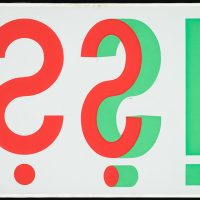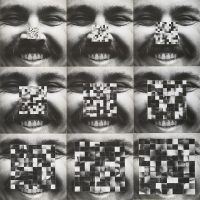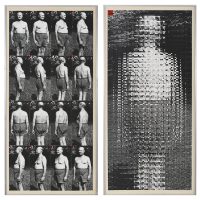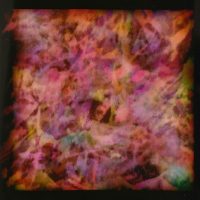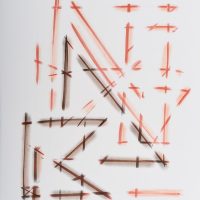Péter Türk: Untitled (Question Mark series), 1971 distemper on canvas, 80 x 100 cm Hungarian National Gallery photo: Andrea Bényi
Péter Türk: 100 Chance Elements in the Face, 1970s, black-and-white photograph: gelatin silver bromide print on cardboard, 40 x 40 cm, from the artist’s estate, photo: József Rosta
Péter Türk: Treadmill I–II, 1975–1981 photo: gelatin silver bromide print on paper, 100.5 x 49.5 cm each, Ludwig Museum – Museum of Contemporary Art, photo: József Rosta
Péter Türk: Psychograms. Studies of Eye Movement in an Empty Square, and on an Empty Picture Plane, c. 1980 paper, colour photo, 20 x 12.5 cm, from the artist’s estate, photo: József Rosta
Péter Türk: Bread-Water (detail), 1990 glue and powder paint on paper, 70 x 50 cm each, from the artist’s estate, photo: József Rosta
Péter Türk was born in Pestszenterzsébet in 1943. He attended the Fine Arts Grammar School of Budapest between 1957–1961, and from 1964, following several unsuccessful entrance exams, he studied art and Hungarian language and literature at the Teachers’ Training College of Eger. In the intervening period he learned typesetting. Following his graduation in Eger, he almost immediately joined the circuit of Hungarian neo-avant-garde art.
This phase of his career more or less fit in the well-known, and yet transient, coordinates and trends of the period, up to the end of the 1980s. Marked by lyrical abstraction and a French orientation, the early works were followed by reliefs and graphic works that harmonized organic forms and patterns with geometric ones, and which were in turn succeeded by series of charcoal drawings and easel paintings with a minimalist approach, a reduced palette and set of forms.
The series of the early seventies, conceptual in slant, analytical in approach, and often involving “mathematical programmes,” earned him a firm position in the (new) geometric and structuralist art of Hungary. Following the conceptual phase of his art, from the middle of the 1970s his interest turned to the creation of original, photo-based imaging and recording techniques that served his own disposition and purposes. The associative series, the woven images, the psychograms and the phenomena were all informed by an interest in the psychology of vision, and an inquiry into the logical relations of imaging and recollection.
The spiritual force of an unexpected event, his 1989 experience of God – which made him refrain from making art for one and a half years – caused a fundamental turn in Türk’s life, and his notions on the hierarchy of art, science and faith. Formerly rich in styles, genres and parallel “stories,” his work became more focussed. He explored questions through series, over periods extending from five to ten years, bringing to light a transcendental world that was endless and in hiding, yet awaited and desired to be known.
Objects and phenomena that may seem rather mundane could act as “thought magnets” or “objects of meditation,” and the same everyday phenomena could open the way to concentrated attention, the creation of images “without human contribution.” The human or mechanical algorithms – cumulative drawing, the layering of images and negatives, variations on the rolling of a brick – were means of approach to a hidden and invisible world of images that was willing to reveal itself to a receptive artist. As a result of this “fishing for images,” infinity—“perfection unfit for humans”—is glimpsed, while it confronts us with our limitations.
If the God- experience divides the oeuvre into two periods, works and sets of works in the two phases are interlinked, in manners either obvious or initially difficult to discern. This exhibition seeks to call attention to this system of spatial and temporal relations, changeable while containing permanent elements, by highlighting their major essential motifs, and patterns that transmute into each other. For the same reason, the display is based on relatively loose, though easy-to-follow chronologies, which run through the nodes of some important set of themes (question mark actions), an important location (the garden in Balatonszepezd), or some long-term artistic programme (cumulative drawings, brick works)—and may in certain cases concentrate the work of decades.
Péter Türk created a large and complex oeuvre, with (what may seem) frequent repetitions and small, barely noticeable shifts. It is like a carpet with a complex pattern: the viewer must slow down and allow time to distinguish the threads, motifs and patterns, to follow their meandering, to understand the trains of thought. The attentive viewer will be rewarded with one of the most exciting, but hitherto lesser known, oeuvres of modern visual art in post-World War II Hungary.
